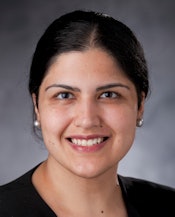
A machine-learning algorithm designed to distinguish high-risk breast lesions from those not likely to become cancer could reduce unnecessary surgeries by 30%, according to a new study published online October 17 in Radiology.
The study findings suggest that using this kind of artificial intelligence (AI) tool could lead to more targeted, personalized healthcare and help avoid overtreatment, wrote a team led by Dr. Manisha Bahl of Massachusetts General Hospital (MGH). The study was a collaboration between MGH and the Massachusetts Institute of Technology's (MIT) Computer Science and Artificial Intelligence Laboratory.
"Our study focused on high-risk breast lesions, of which there are many types and much controversy about how to manage them," Bahl told AuntMinnie.com. "What's exciting about this research is that we can use information about our patients' breast cancer risk, as well as imaging and biopsy results, to better determine which lesions should be excised and which could be surveilled."
Status quo?
 Dr. Manisha Bahl from MGH.
Dr. Manisha Bahl from MGH.Most high-risk breast lesions found on mammography turn out to be benign. But women are often recommended for surgical excision because of a low but real potential for the lesion to upgrade to ductal carcinoma in situ (DCIS) or invasive malignancy, said study co-author Regina Barzilay, PhD, in a statement released by the RSNA. Barzilay is a professor of electrical engineering and computer science at MIT.
"Because diagnostic tools are inexact, there is an understandable tendency for doctors to overscreen for breast cancer," Barzilay said. "When there's this much uncertainty in data, machine learning is exactly the tool that we need to improve detection and prevent overtreatment."
To investigate how to better determine whether surgical excision is needed, the researchers developed a machine-learning algorithm that would help distinguish high-risk breast lesions requiring surgical removal from lesions that could be followed with surveillance. The algorithm includes features such as age, lesion histological data, and particular text from biopsy pathology reports (phrases such as "atypical ductal," "severely," "atypical," and "severely atypical").
The group tested the algorithm in 986 patients with biopsy-proven high-risk lesions who underwent either surgery or at least two years of imaging follow-up between June 2006 and April 2015. From the study cohort, Bahl's team identified 1,006 high-risk lesions, 11.4% of which were upgraded to cancer. The group used 671 of these high-risk lesions to develop the machine-learning model, and 335 of them to test it. Surgical pathology reports were available for 963 of the 1,006 high-risk lesions (95.7%), and at least two years of imaging follow-up were available for the 43 lesions that were not excised.
Instead of going straight to surgical removal of all high-risk lesions, use of the model would have ensured that most malignant cancers were removed while dramatically reducing the number of surgeries for benign lesions, the researchers found. If lesions categorized by the model as low-risk were followed with surveillance and the remainder removed, 97.4% of malignancies would have been diagnosed at surgery. In all, 30.6% of surgeries for benign lesions would be avoided.
 Dr. Constance Lehman, PhD, from MGH.
Dr. Constance Lehman, PhD, from MGH."In comparison with current practice at our institution, there would have been no statistically significant difference in the proportion of cancers detected, but fewer surgeries of benign lesions would have been performed ... with the use of the machine-learning model," the authors wrote.
When you add the fact that the model can be further improved, it's an exciting time for breast imaging, senior author Dr. Constance Lehman, PhD, also of MGH, told AuntMinnie.com.
"For this study, we didn't give the machine the actual pathology slides or the actual mammograms, and it still performed with high accuracy," she said. "This explosion of machine learning in healthcare is pretty exciting: We get to magnify our impact as radiologists by using machines in better ways, and to solve clinical problems we haven't been able to solve before."
So does this type of machine learning represent a threat to radiologists? Not necessarily, according to Bahl.
"I don't think radiologists should fear machine learning," she said. "We can gain a lot from being open to it and how it could help us better care for patients."
Risk assessment
The paradigm of surveillance rather than more aggressive intervention is increasingly important in the era of shared informed decision-making, and it has precedence, the researchers noted: Lesions identified at mammography as "probably benign" are expected to have less than a 2% risk of malignancy and to receive follow-up rather than core needle biopsy. So it's possible that patients and their providers might accept a slightly higher risk of malignancy in high-risk lesions if surgical excision could be avoided, they wrote.
Using a machine-learning model to assess high-risk lesions could support a more nuanced approach to handling them -- one that includes surveillance as an option, according to Lehman.
"Years ago we were all nervous about short-interval follow-up for circumscribed round or oval masses -- we didn't want to risk missing a cancer. But women were having surgeries on benign lesions, and we've shifted to a surveillance model in this particular case that is effective," she said. "Our research addresses a similar clinical issue: Can we watch and wait when it comes to these high-risk lesions, and avoid unnecessary excisions? The answer appears to be yes. Machine learning can not only decrease unnecessary surgery by nearly one-third in this specific patient population, but it can also support more targeted, personalized approaches to patient care."




















